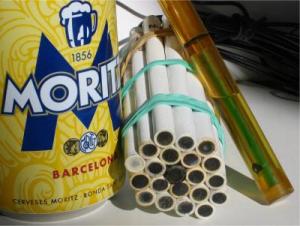Jan 31 2014
Spanish researchers have managed to distinguish between different varieties of beer using an electronic tongue. The discovery, published in the journal 'Food Chemistry', is accurate in almost 82% of cases.
 Spanish researchers have managed to distinguish between different varieties of beer using an electronic tongue. The discovery, published in the journal 'Food Chemistry', is accurate in almost 82 percent of cases. Credit: Manel del Valle
Spanish researchers have managed to distinguish between different varieties of beer using an electronic tongue. The discovery, published in the journal 'Food Chemistry', is accurate in almost 82 percent of cases. Credit: Manel del Valle
Beer is the oldest and most widely consumed alcoholic drink in the world. Now, scientists at the Autonomous University of Barcelona have led a study which analysed several brands of beer by applying a new concept in analysis systems, known as an electronic tongue, the idea for which is based on the human sense of taste.
As Manel del Valle, the main author of the study, explains to SINC: "The concept of the electronic tongue consists in using a generic array of sensors, in other words with generic response to the various chemical compounds involved, which generate a varied spectrum of information with advanced tools for processing, pattern recognition and even artificial neural networks."
In this case, the array of sensors was formed of 21 ion-selective electrodes, including some with response to cations (ammonium, sodium), others with response to anions (nitrate, chloride, etc.), as well as electrodes with generic (unspecified) response to the varieties considered.
The authors recorded the multidimensional response generated by the array of sensors and how this was influenced by the type of beer considered. An initial analysis enabled them to change coordinates to view the grouping better, although it was not effective for classifying the beers.
"Using more powerful tools – supervised learning – and linear discriminant analysis did enable us to distinguish between the main categories of beer we studied: Schwarzbier, lager, double malt, Pilsen, Alsatian and low-alcohol," Del Valle continues, "and with a success rate of 81.9%."
Furthermore, it is worth noting that varieties of beers that the tongue is not trained to recognise, such as beer/soft drink mixes or foreign makes, were not identified (discrepant samples), which, according to the experts, validates the system as it does not recognise brands for which it was not trained.
Robots with the sense of taste
In view of the ordering of the varieties, which followed their declared alcohol content, the scientists estimated this content with a numerical model developed with an artificial neural network.
"This application could be considered a sensor by software, as the ethanol present does not respond directly to the sensors used, which only respond to the ions present in the solution," outlines the researcher.
The study concludes that these tools could one day give robots a sense of taste, and even supplant panels of tasters in the food industry to improve the quality and reliability of products for consumption.